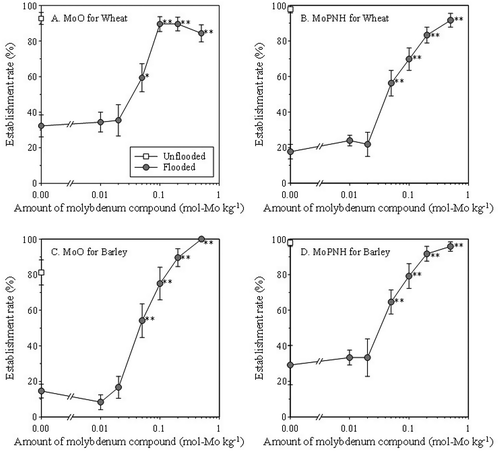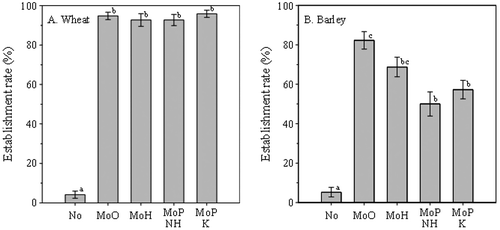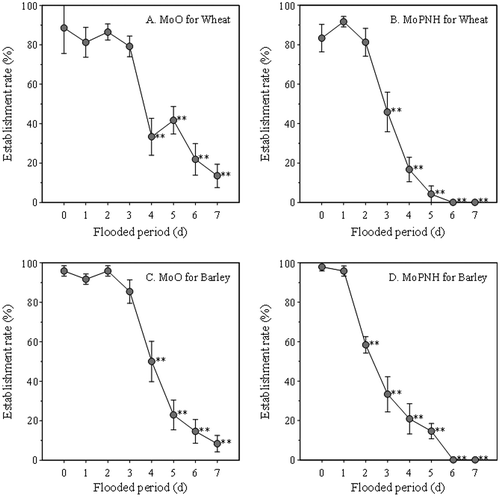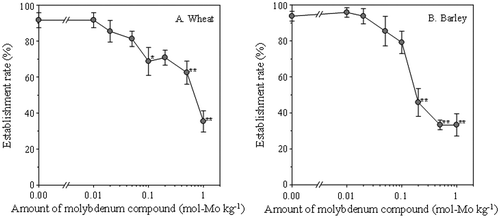Abstract
Wheat and barley are often cultivated also in paddy fields in winter in Japan. The drainage of paddy fields is often poor. The seedling establishment of wheat and barley is more prone to become poor if it rains heavily after sowing. The flooding damage on seedling establishment is thought to be caused by many factors. The generation of sulfide ions in flooded and reduced soil is thought to be one factor of the flooding damage. In this study, the effect of seed coating with molybdenum compounds, which suppress the generation of sulfide ions, on the flooding damage of wheat and barley seedling establishment. Two poorly soluble molybdenum compounds were coated on wheat or barley seeds at different amounts. Coated seeds were sown in soil and soon flooded for 2 d at 20 °C. When seeds were not coated with molybdenum compounds, rates of seedling establishment were no more than 32%. However, when any molybdenum compounds of .05–.5 mol-Mo kg−1 were coated, seedling establishment was significantly improved and rates of seedling establishment were no less than 54%. However, when sown seed were not flooded, the establishment rates of the seeds, which were coated with a molybdenum compound of no less than .1 or .2 mol-Mo kg-1, were significantly decreased. Accordingly, coating of molybdenum compounds could improve the seedling establishment of coated seeds under flooded condition, but might impair the seedling establishment of coated seeds under unflooded condition.
Introduction
Wheat [Triticum aestivum L.] and barley [Hordeum vulgare L.] are often cultivated also in paddy fields in winter in Japan. The drainage of paddy fields is often poor. Wheat and barley are suitable to grow in dry climate. They are susceptible to wet damage (Kawaguchi, Citation2010). Wet damage is distinguished into that in the stage of seedling establishment and that in the stage of plant-growing or grain-filling period. There are more attention and more studies on overcoming the damage in the latter stage (Tani et al., Citation2015). However, if it rains heavily after sowing, their fields are flooded and their seeds rot. Such flooding damage causes the decreases in seedling establishment (Oyanagi, Citation2008; Yamamoto et al., Citation1999). This decrease causes the decrease in the yield (Inamura et al., Citation2007). The occurrence of flood or wet damage of wheat and barley would be associated with environmental factors and crop characteristic factors (Kawaguchi, Citation2010). The generation of sulfide ion in reduced soil seems to be also one of the environmental factors.
When the rice seeds are sown in submerged soil at 20 °C, the soil around sown seeds was rapidly reduced in the level that harmful sulfide ion could generate (Hara, Citation2013a). The establishment of rice plants was impaired by the generation of the sulfide ions. The molybdate ions suppress the generation of sulfide ions (Biswas et al., Citation2009; Hori et al., Citation1990). The application and seed coating of molybdenum compounds improved the establishment of rice seedling (Hara, Citation2013b, 2013c). Seed coating of molybdenum compounds improved the establishment of also soybean seedling after flood condition (Hara, Citation2015). Accordingly, the generation of sulfide ions might be one factor of the flooding damage for wheat and barley. Also flooding damage of wheat or barley might be improved by seed coating of molybdenum compounds.
In this study, the effect of seed coating with molybdenum compounds on the seedling establishment of wheat and barley after flood condition was investigated.
Materials and methods
Effect of seed coating using different amounts of molybdenum compounds on seedling establishment under a flooded condition (Exp. 1)
Wheat seeds (cv. Chikugoizumi) or barley seeds (cv. Nishinochikara) were used for the following experiments. Air-dried seeds were soaked in a polyvinyl alcohol solution containing a 10% diluted commercial laundry detergent for 1 min, spin-dried, and then coated with molybdenum trioxide (MoO, for short; hereinafter the same shall apply) or ammonium phosphomolybdate (MoPNH). The coated amount of each molybdenum compound was .00, .01, .02, .05, .1, .2, or .5 mol-Mo kg−1 (per air-dried seeds).
Moist soil (fine-textured gray lowland soil, light clay) was obtained from the topsoil (ca. 0–10 cm in depth) of a paddy field located in Chikugo, Fukuoka Prefecture, Japan. The water content of the soil was about 25% by weight. The soil was refrigerated without previous drying until use. Wet soil equivalent to 100 g of dry soil was placed in pots (8 cm in diameter, 8 cm high, glass, without holes at the bottom). A solution containing ammonium sulfate (corresponded to 4 mmol kg−1 dried soil), and potassium chloride (corresponded to 1 mmol kg−1 dried soil) was added to each pot until the total amount of water was .7 times the weight of dry soil. The applied amount of ammonium sulfate corresponded to 11 g m−2 nitrogen, assuming that 100 kg dried soil corresponded to 1 m2.
Eight seeds coated with each amount of each molybdenum compound were sown on soil surface and were pushed down using a board until the top of seeds was located at the soil surface. The pots were placed in growth chamber, which air temperature is controlled at 20 °C, with fluorescent lamp (ca. 100 μmol m−2 s−1, 12 h d−1). Then, distilled water was added in pots and water level was maintained at about 15 mm above the soil surface. Two days after sowing, water on soil surface was removed using a pipette. This condition was termed as ‘flooded condition’. Separately, seeds that were not coated with molybdenum compounds were sown in the same way but were not flooded. This condition was termed as ‘unflooded condition’. Only enough water to be absorbed by soil was added when the bottom of soil was dried. Rates of seedling establishment were measured about 2 wk after sowing. Seedling establishment was determined by the appearance of the second leaf. Six pots were examined for each condition.
Effect of seed coating using different kinds of molybdenum compounds on seedling establishment under a flooded condition (Exp. 2)
As mentioned above, seeds of wheat or barley were coated with four kinds of poorly soluble molybdenum compounds, which was molybdenum trioxide (MoO), molybdic acid (MoH), ammonium phosphomolybdate (MoPNH), or potassium phosphomolybdate (MoPK). The coated amount of each molybdenum compound was .5 mol-Mo kg−1. Similarly, pots containing soil were prepared. These coated seeds or uncoated seeds were sown in the pots and were flooded in the growth chamber of 20 °C. Three days after sowing, water on soil surface was removed. Seedling establishment was determined in the same way. Six pots were examined for each condition in an experiment. Two experiments were carried out in the different time.
Effect of seed coating using the molybdenum compound on seedling establishment after different flooded periods (Exp. 3)
As mentioned above, seeds of wheat or barley were coated with molybdenum trioxide (MoO) or ammonium phosphomolybdate (MoPNH) of .5 mol-Mo kg−1. Similarly, pots containing soil were prepared. These coated seeds were sown in the pots and were flooded in the growth chamber of 20 °C. Water on soil surface was removed 0 d (soon after sowing), 1, 2, 3, 4, 5, 6, or 7 d after sowing. Seedling establishment was determined in the same way. Six pots were examined for each condition.
Effect of seed coating with different amounts of a molybdenum compound on seedling establishment under a non-flooded condition (Exp. 4)
As mentioned above, seeds of wheat or barley were coated with molybdenum trioxide (MoO) of .00, .01, .02, .05, .1, .2, .5, or 1 mol-Mo kg−1. Similarly, pots containing soil were prepared. These coated seeds were sown in the pots. However, soil was not flooded. Only enough water to be absorbed by soil was added when the bottom of soil was dried. Seedling establishment was determined in the same way. Six pots were examined for each condition.
Results
Effect of seed coating using different amounts of molybdenum compounds on seedling establishment under a flooded condition (Exp. 1)
As for wheat, when seeds that were not coated with molybdenum compounds were sown under unflooded condition, the establishment rate of seedling was 93% or 98% (Figure A and B). However, when the seeds were sown under flooded condition, the establishment rates declined to 32% or 18%. When seeds were coated with MoO of .05–.5 mol-Mo kg−1 per seed weight, establishment rates of seedlings improved significantly (Figure A). Also when seeds were coated with MoPNH of .05–.5 molMo kg−1, establishment rates improved significantly (Figure B).
Figure 1. Effects of seed coatings with different amounts of molybdenum compounds on seedling establishment rates under a flooded condition. Seeds of wheat or barley were coated with molybdenum trioxide (MoO) or ammonium phosphomolybdate (MoPNH). Sown seeds were flooded for 2 d. Open square means the establishment rate, in which seeds were under an unflooded condition. Error bars represent standard errors (n = 6). **p < 0.01, *p < 0.05 vs. flooded samples lacking molybdenum compounds (Dunnett's multiple comparison).

As for barley, when seeds that were not coated with molybdenum compounds were sown under unflooded condition, the establishment rate of seedling was 81 or 98% (Figure C and D). However, when the seeds were sown under flooded condition, the establishment rates declined to 15% or 29%. When seeds were coated with MoO of .05–.5 mol-Mo kg−1 per seed weight, the establishment rates of seedlings improved significantly (Figure C). Also when seeds were coated with MoPNH of .05–.5 molMo kg−1, the establishment rates improved significantly (Figure D).
Effect of seed coating using different kinds of molybdenum compounds on seedling establishment under a flooded condition (Exp. 2)
As for wheat, according to two-way analysis of variance, establishment rate of seedling had significant difference on only seed coatings (p = .00) or the interaction (p = .04) but had no significant difference on two experiments (p = .84). The average rate of seedling establishment was 4% when seeds were not coated (Figure A). The rate improved significantly even when seeds were coated with either molybdenum compound. The rate showed no significant difference among those of any compounds.
Figure 2. Effects of seed coating with different kinds of molybdenum compounds on seedling establishment rates under a flooded condition. Seeds of wheat or barley were uncoated (No), or coated with molybdenum trioxide (MoO), molybdic acid (MoH), ammonium phosphomolybdate (MoPNH), or potassium phosphomolybdate (MoPK). Sown seeds were flooded for 3 d. Error bars represent standard errors (n = 12). Different alphabets mean significant difference at 5% (Tukey’s multiple comparison).

As for barley, according to two-way analysis of variance, establishment rate of seedling had significant difference on only seed coatings (p = .00) but had no significant difference on two experiments (p = .92) or the interaction (p = .45). The average rate of seedling establishment was 5% when seeds were not coated (Figure B). The rate improved significantly even when seeds were coated with either molybdenum compound. The rate in seeds coated with MoO showed significantly higher establishment than that of MoPNH or MoPK. That of MoH was middle and did not show significant difference from that of the other molybdenum compounds.
Effect of seed coating using the molybdenum compound on seedling establishment after different flooded periods (Exp. 3)
In the case where wheat seeds were coated with MoO, the establishment rate was 89% when flooded period was 0 d (Figure A). The rate did not decline significantly when the period was no more than 3 d, but declined significantly when the period was no less than 4 d.
Figure 3. Effects of seed coatings with a molybdenum compound on seedling establishment rates after different flooding periods. Seeds of wheat or barley were coated with molybdenum trioxide (MoO) or ammonium phosphomolybdate (MoPNH). Error bars represent standard errors (n = 6). **p < .01 vs. flooded samples for 0 d (Dunnett’s multiple comparison).

In the case where wheat seeds were coated with MoPNH, the establishment rate was 83% when flooded period was 0 d (Figure B). The rate did not decline significantly when the period was no more than 2 d, but declined significantly when the period was no less than 3 d. No seedling established when the period was no less than 6 d.
In the case where barley seeds were coated with MoO, the establishment rate was 96% when flooded period was 0 d (Figure C). The rate did not decline significantly when the period was no more than 3 d, but declined significantly when the period was no less than 4 d.
In the case where barley seeds were coated with MoPNH, the establishment rate was 98% when flooded period was 0 d (Figure D). The rate did not decline significantly when the period was no more than 1 d, but declined significantly when the period was no less than 2 d. No seedling established when the period was no less than 6 d.
Effect of seed coating with different amounts of a molybdenum compound on seedling establishment under a non-flooded condition (Exp. 4)
When wheat seeds were not coated, the establishment rate was 92% (Figure A). However, increasing coated amount of MoO up to .1 mol-Mo kg−1 declined the establishment rate. When the coated amount of MoO was 1 mol-Mo kg−1, the rate decreased to 35% significantly.
Figure 4. Effects of seed coatings with different amounts of a molybdenum compound on seedling establishment rates under a non-flooded condition. Seeds of wheat or barley were coated with molybdenum trioxide (MoO). Error bars represent standard errors (n = 6). **p < .01 vs. samples lacking molybdenum compounds (Dunnett’s multiple comparison).

When barely seeds were not coated, the establishment rate was 94% (Figure B). However, increasing coated amount of MoO up to 0.2 mol-Mo kg−1 declined the establishment rate. When the coated amount of MoO was 1 mol-Mo kg−1, the rate decreased to 33% significantly.
Discussion
When seeds of wheat or barley were sown and kept under flooded condition for 2–3 d, rates of seedling establishment of seeds not coated with molybdenum compounds were lower than 40% (Figures and ). When seeds were coated with no more than .02 mol-Mo kg−1 of molybdenum compounds, the rates of seedling establishment were not improved. However, when the seeds were coated with a molybdenum compound at the rate of .05–.5 mol-Mo kg−1, the seedling establishment was improved. At a coating rate of .5 mol-Mo kg−1, the seedling establishment was improved regardless of the kind of molybdenum compounds (Figure ). These results indicate that the seed coating with molybdenum compounds improved the impaired establishment of seedlings flooded for a few days, as well as in the rice seeds (Hara, Citation2013c) and soybean seeds (Hara, Citation2015) sown in flooded condition.
Establishment rates of wheat and barley seeds decreased under 40% when flooded period gets long to 3–5 d, establishment rate was decreased noticeably (Figure ). Accordingly, the improvement effect on seedling establishment of wheat and barley by coating with molybdenum compounds may have limited effectiveness against flood damage.
It would be take at least 4 d at 20 °C for sulfate ions to change to sulfide ions (Hara, Citation2013a). The reason that the coating of molybdenum compounds improves the seedling establishment might be the fact that molybdate ions solved from molybdenum compounds suppress the generation of sulfide ions. However, it does not deny the possibility that the improvement might also be caused by a mechanism other than the inhibition of the generation of sulfide ions. For example, the molybdenum compound might improve the seedling establishment by directly inhibiting the multiplication of microorganisms like the microbicide. Accordingly, further analyses would be necessary for investigating the effect of molybdenum compounds.
The effect of the coating with a molybdenum compound on the wheat or barley establishment after flooding seemed to increase with the increase in the molybdenum compound up to .5 mol-Mo kg−1 (Figure ). However, the seedling establishment under a non-flooded condition seemed to be inhibited by coating with a molybdenum compound above .1 mol-Mo kg−1 (Figure ). The inhibition under a non-flooded condition was also observed for soybean (Hara, Citation2015). Coated molybdenum compound around seeds elutes soluble molybdate ions. Under a non-flooded condition, molybdate ions may become concentrated around seeds. Under flooded condition, however, some molybdate ions may disperse from the circumference of seeds. The moderate concentration of molybdate ions would improve the seedling establishment, but excess concentration of molybdate ions may inhibit the growth of seedling. Accordingly, coating the seed with a molybdenum compound would improve the seedling establishment under a flooded condition but inhibit the growth at a high concentration. The appropriate amount of molybdenum compound would be about .05–.1 mol-Mo kg−1.
All four molybdenum compounds examined improved seedling establishment under a flooded condition (Figure ). In wheat, the improvement effect had no difference by the kind of molybdenum compounds. However, MoO might have a better improvement effect than other molybdenum compounds according to the result of barley. The reason why the results were different between wheat and barley was not clear. In addition, MoO was the cheapest in the molybdenum compounds examined. At the current cost of about 3,000 yen kg−1, the cost for the coating would be about 40 yen kg−1 (per seeds) at the coating rate of .1 mol-Mo kg−1. Because the cost is enough low, coating the seeds might be a practical for cultivations in cost.
The temperature at which wheat or barley are sowed in actual cultivation is often under 10 °C. However, these experiments were conducted at 20 °C to shorten the time of establishment, also because of low cooling capacity of growth chamber. Accordingly, the effect of the coating with a molybdenum compound at colder temperature is not clear. Additional validations would be necessary for assessing whether the coating with a molybdenum compound is available to avoid the flooding damage in actual cultivation of wheat or barley.
Acknowledgements
I thank Mr. N. Yasui (Japan New Metals co., Ltd.) for supply of potassium phosphomolybdate and helpful comments on molybdenum materials; Dr. K. Hatta (NARO) for valuable advice on wheat and barley; Mr. K. Masuda, and Dr. K. Nakano (NARO) for general advice; and Mrs. T. Tajima, Mrs. K. Sekimoto, Mrs. M. Setoguchi and Mrs. S. Nakao (NARO) for assistance with the experiments.
References
- Biswas, K. C., Woodards, N. A., Xu, H., & Barton, L. L. (2009). Reduction of molybdate by sulfate-reducing bacteria. BioMetals, 22, 131–139.10.1007/s10534-008-9198-8
- Hara, Y. (2013a). Suppressive effect of sulfate on establishment of rice seedlings in submerged soil may be due to sulfide generation around the seeds. Plant Production Science, 16, 50–60.10.1626/pps.16.50
- Hara, Y. (2013b). Improvement of rice seedling establishment in sulfate-applied submerged soil by application of molybdate. Plant Production Science, 16, 61–68.10.1626/pps.16.61
- Hara, Y. (2013c). Improvement of rice seedling establishment on sulfate-applied submerged soil by seed coating with poorly soluble molybdenum compounds. Plant Production Science, 16, 271–275.10.1626/pps.16.271
- Hara, Y. (2015). Improvement of soybean seedling establishment under a flooded condition by seed coating with molybdenum compounds. Plant Production Science, 18, 161–165.10.1626/pps.18.161
- Hori, K., Inubushi, K., Matsumoto, S., & Wada, H. (1990). Appropriate concentration of inhibitors for methane formation and sulfate reduction in submerged soil system. Japanese Journal of Soil Science and Plant Nutrition, 61, 647–648**.
- Inamura, T., Yoshikawa, A., Matsumoto, K., Ikenaga, S., Inoue, H., & Yamasue, Y. (2007). Analysis of the sources of variations of wheat yield in the field, and possibility of the variable rate management. Japanese Journal of Crop Science, 76, 189–197*.10.1626/jcs.76.189
- Kawaguchi, K. (2010). Wheat, barley and etc. (Mugirui). In J. Kawakami, et al. (Eds.), Wetland environment and crop (Shicchikankyo to sakumotsu), (pp. 139–150). Tokyo:Youkendo **.
- Oyanagi, A. (2008). Relationship of growth variability, with ground level and soil water content in a large paddy field in Inashiki-city, Ibaraki-prefecture in 2007. Japanese Journal of Crop Science, 77, 511–515*.10.1626/jcs.77.511
- Tani, T., Hayashi, M., Endou, I., Mitsuya, S., Hayashi, T., & Yamauchi, A. (2015). Effects of a combination of application of controlled-release fertilizer to surface soil and top dressing with quick-acting fertilizer on the growth of common wheat under excess moisture conditions: a technique to mitigate excess moisture injury. Japanese Journal of Crop Science, 84, 256–263*.10.1626/jcs.84.256
- Yamamoto, H., Iwaya, K., Suzuki, K., Suzuki, Y., Hirashima, T., & Hamano, T. (1999). Damage of wheat and barley in 1998 harvest year by unusual weather in Kyushu and Yamaguchi districts. Japanese Journal of Crop Science, 68, 310–315*.10.1626/jcs.68.310